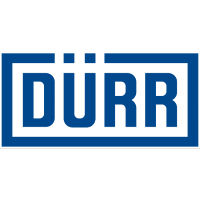
Duerr AG
XETRA:DUE


| US |

|
Johnson & Johnson
NYSE:JNJ
|
Pharmaceuticals
|
| US |

|
Berkshire Hathaway Inc
NYSE:BRK.A
|
Financial Services
|
| US |

|
Bank of America Corp
NYSE:BAC
|
Banking
|
| US |

|
Mastercard Inc
NYSE:MA
|
Technology
|
| US |

|
UnitedHealth Group Inc
NYSE:UNH
|
Health Care
|
| US |

|
Exxon Mobil Corp
NYSE:XOM
|
Energy
|
| US |

|
Pfizer Inc
NYSE:PFE
|
Pharmaceuticals
|
| US |

|
Palantir Technologies Inc
NYSE:PLTR
|
Technology
|
| US |

|
Nike Inc
NYSE:NKE
|
Textiles, Apparel & Luxury Goods
|
| US |

|
Visa Inc
NYSE:V
|
Technology
|
| CN |

|
Alibaba Group Holding Ltd
NYSE:BABA
|
Retail
|
| US |

|
3M Co
NYSE:MMM
|
Industrial Conglomerates
|
| US |

|
JPMorgan Chase & Co
NYSE:JPM
|
Banking
|
| US |

|
Coca-Cola Co
NYSE:KO
|
Beverages
|
| US |

|
Walmart Inc
NYSE:WMT
|
Retail
|
| US |

|
Verizon Communications Inc
NYSE:VZ
|
Telecommunication
|
Utilize notes to systematically review your investment decisions. By reflecting on past outcomes, you can discern effective strategies and identify those that underperformed. This continuous feedback loop enables you to adapt and refine your approach, optimizing for future success.
Each note serves as a learning point, offering insights into your decision-making processes. Over time, you'll accumulate a personalized database of knowledge, enhancing your ability to make informed decisions quickly and effectively.
With a comprehensive record of your investment history at your fingertips, you can compare current opportunities against past experiences. This not only bolsters your confidence but also ensures that each decision is grounded in a well-documented rationale.
Do you really want to delete this note?
This action cannot be undone.

| 52 Week Range |
17.85
25.66
|
| Price Target |
|
We'll email you a reminder when the closing price reaches EUR.
Choose the stock you wish to monitor with a price alert.

|
Johnson & Johnson
NYSE:JNJ
|
US |

|
Berkshire Hathaway Inc
NYSE:BRK.A
|
US |

|
Bank of America Corp
NYSE:BAC
|
US |

|
Mastercard Inc
NYSE:MA
|
US |

|
UnitedHealth Group Inc
NYSE:UNH
|
US |

|
Exxon Mobil Corp
NYSE:XOM
|
US |

|
Pfizer Inc
NYSE:PFE
|
US |

|
Palantir Technologies Inc
NYSE:PLTR
|
US |

|
Nike Inc
NYSE:NKE
|
US |

|
Visa Inc
NYSE:V
|
US |

|
Alibaba Group Holding Ltd
NYSE:BABA
|
CN |

|
3M Co
NYSE:MMM
|
US |

|
JPMorgan Chase & Co
NYSE:JPM
|
US |

|
Coca-Cola Co
NYSE:KO
|
US |

|
Walmart Inc
NYSE:WMT
|
US |

|
Verizon Communications Inc
NYSE:VZ
|
US |
This alert will be permanently deleted.
 Duerr AG
Duerr AG
Duerr AG
Investor Relations
Duerr AG, a stalwart in the industrial landscape, stands as an exemplar of German engineering prowess, with roots tracing back to 1895. Headquartered in Stuttgart, this company has evolved deftly over the decades, specializing in high-tech mechanical and plant engineering solutions. Duerr’s primary clientele hails from the automotive industry, but its influence extends across various sectors including woodworking and the chemical industry. Through its well-diversified five divisions—Paint and Final Assembly Systems, Application Technology, Clean Technology Systems, Measuring and Process Systems, and Woodworking Machinery—Duerr crafts solutions that enhance production efficiency. The Paint and Final Assembly Systems division, for instance, offers cutting-edge technology for vehicle body painting and assembly, ensuring that Duerr remains a key partner to major automotive giants.
In today’s rapidly advancing world, Duerr capitalizes on its innate ability to integrate digital technology with industrial applications. The company accrues substantial revenue from offering intelligent production processes and specialized equipment. In the realm of digital transformation, its business model thrives by offering smart data analytics and consulting services to optimize manufacturing operations. Furthermore, Duerr’s commitment to sustainability is evidenced through its Clean Technology Systems division, which addresses the growing demand for exhaust-air purification and energy-efficiency solutions. By aligning traditional engineering with contemporary digital approaches, Duerr AG ensures its portfolio remains robust and relevant, with a clear focus on fostering long-term partnerships anchored in innovation and efficiency.

Duerr AG, a stalwart in the industrial landscape, stands as an exemplar of German engineering prowess, with roots tracing back to 1895. Headquartered in Stuttgart, this company has evolved deftly over the decades, specializing in high-tech mechanical and plant engineering solutions. Duerr’s primary clientele hails from the automotive industry, but its influence extends across various sectors including woodworking and the chemical industry. Through its well-diversified five divisions—Paint and Final Assembly Systems, Application Technology, Clean Technology Systems, Measuring and Process Systems, and Woodworking Machinery—Duerr crafts solutions that enhance production efficiency. The Paint and Final Assembly Systems division, for instance, offers cutting-edge technology for vehicle body painting and assembly, ensuring that Duerr remains a key partner to major automotive giants.
In today’s rapidly advancing world, Duerr capitalizes on its innate ability to integrate digital technology with industrial applications. The company accrues substantial revenue from offering intelligent production processes and specialized equipment. In the realm of digital transformation, its business model thrives by offering smart data analytics and consulting services to optimize manufacturing operations. Furthermore, Duerr’s commitment to sustainability is evidenced through its Clean Technology Systems division, which addresses the growing demand for exhaust-air purification and energy-efficiency solutions. By aligning traditional engineering with contemporary digital approaches, Duerr AG ensures its portfolio remains robust and relevant, with a clear focus on fostering long-term partnerships anchored in innovation and efficiency.





























 You don't have any saved screeners yet
You don't have any saved screeners yet
